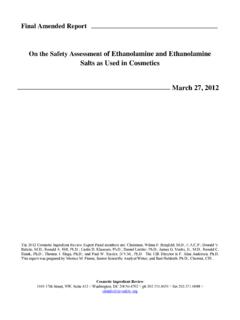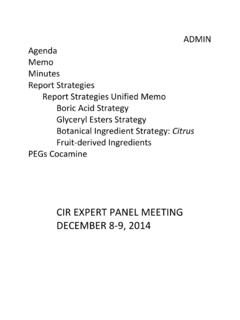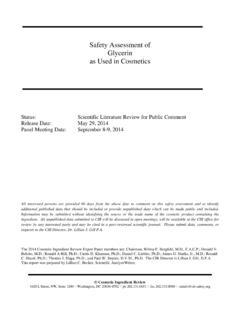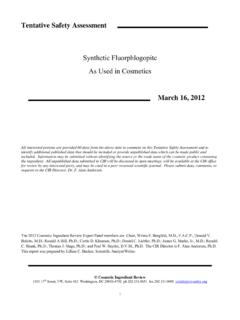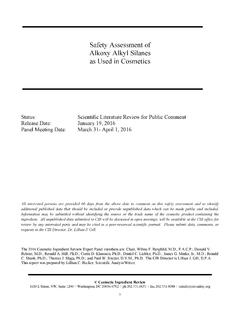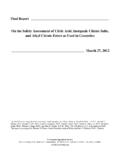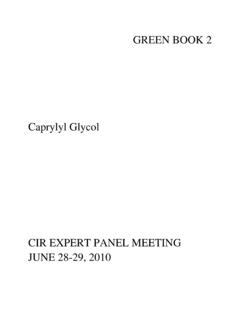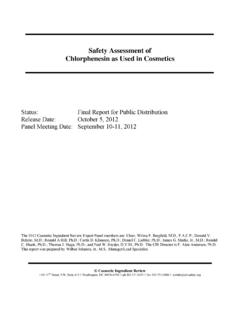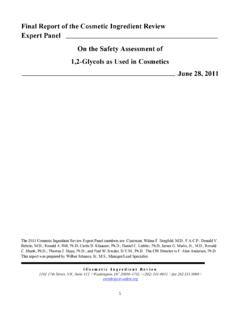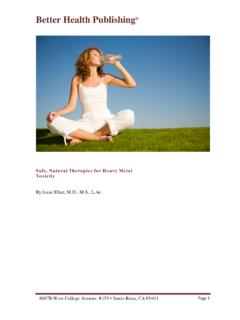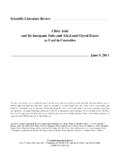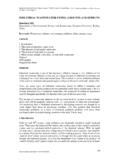Transcription of Safety Assessment of Amino Acid Alkyl Amides as …
1 Safety Assessment of Amino acid Alkyl Amides as Used in cosmetics Status: Scientific Literature Review for Public Comment Release Date: February 11, 2013 Panel Meeting Date: June 10-11, 2013 The 2013 cosmetic Ingredient Review Expert Panel members are: Chairman, Wilma F. Bergfeld, , ; Donald V. Belsito, ; Ronald A. Hill, ; Curtis D. Klaassen, ; Daniel C. Liebler, ; James G. Marks, Jr., , Ronald C. Shank, ; Thomas J. Slaga, ; and Paul W. Snyder, , The CIR Director is F. Alan Andersen, This report was prepared by Christina Burnett, Scientific Analyst/Writer, and Bart Heldreth, , Chemist CIR. cosmetic Ingredient Review 1101 17th Street, NW, Suite 412 Washington, DC 20036-4702 ph fax ii Table of Contents Introduction .. 1 Chemistry .. 1 Physical and Chemical Properties.
2 1 Method of Manufacturing .. 1 Impurities .. 1 Use .. 2 cosmetic .. 2 Non- cosmetic .. 2 2 Absorption, Distribution, Metabolism, Excretion .. 2 Toxicological Studies .. 3 Reproductive and Developmental Toxicity .. 3 Genotoxicity .. 3 Carcinogenicity .. 3 Irritation and Sensitization .. 3 Irritation .. 3 Clinical Use .. 4 Summary .. 4 Tables and Figures .. 6 References .. 39 1 INTRODUCTION This scientific literature review summarizes the available data relevant to assessing the Safety of 115 Amino acid Alkyl Amides as used in cosmetics . These ingredients mainly function as skin and hair conditioning agents and as surfactants-cleansing agents in personal care products. The list of ingredients in this report is found in Table 1. By and large, the ingredients in this report will report will rapidly dissociate in the presence of water.
3 The relative exposure, hence, would be to Amino acids and fatty acids, carboxylic acids, or dicarboxylic acids. A concurrent review of the Safety of plant- and animal-derived Amino acid and hydrolyzed protein ingredients as they are used in cosmetics is being performed by the cosmetic Ingredient Review (CIR) Expert Panel. The Panel previously has reviewed the Safety of - Amino acids and concluded that these ingredients are safe for use in cosmetic The Panel also reviewed the following constituents and concluded that these ingredients are safe for use in cosmetic ingredients: coconut acid , olive acid , sunflower seed acid , palm acid , acetic acid , dicarboxylic acids, lauric acid , oleic acid , palmitic acid , stearic acid , and myristic acid . 2-9 The Panel has concluded that data are sufficient to determine Safety for malic The maximum concentrations of use along with summaries of the data included in those existing Safety assessments are provided in Table 2.
4 CHEMISTRY The ingredients in the report, the Amino acid Alkyl Amides , are comprised of Amino acids acylated with acids or acid chlorides at the Amino acid nitrogen, to form Amides . For example, capryloyl glycine is the N-acylation product of glycine with caprylic acid chloride. Capryloyl GlycineNHOOHH3 COClH3 CONHOOHHG lycineCaprylic acid Chloride( Capryloyl Chloride) Figure 1. Synthesis of the Amino acid Alkyl amide, Capryloyl Glycine. A likely metabolic pathway for these ingredients is to be acted upon by amidases, should they penetrate the skin. The net result therein would be the release of the Amino acid (glycine in the above case) and a fatty acid (caprylic acid in the above case). The definitions of the Amino acid Alkyl Amides can be found in Table 1 and the structures can be found in Table 3. Physical and Chemical Properties The ingredients in this report are typically water soluble, waxy solids.
5 Available chemical properties can be found in Table 4. Method of Manufacturing As shown in Figure 1, the ingredients in this report are most commonly manufactured by the acylation of a free amine of an Amino acid with an acyl chloride, a reaction known as the Schotten-Baumann The major side product for this reaction is hydrochloric acid , which can be easily removed. Disodium Capryloyl Glutamate, Sodium Cocoyl Glutamate and Sodium Lauroyl Glutamate According to a supplier, disodium capryloyl glutamate, sodium cocoyl glutamate, and sodium lauroyl glutamate are produced via the Schotten-Baumann The supplier also described the origin of starting materials: glutamic acid is obtained through formation of glucose/molasses or from wheat and capryloyl chloride, cocoyl chloride, and lauroyl chloride are obtained from caprylic acid , coconut acid and lauric acid that come from cleavage and distillation of coconut oil.
6 The respective resultant materials are aqueous solutions comprised of 37%-41% disodium capryloyl glutamate, sodium cocoyl glutamate, and 36%-40% sodium lauroyl glutamate. Impurities Disodium Capryloyl Glutamate A supplier has reported that disodium capryloyl glutamate may contain 4%-6% propylene glycol, 3% caprylic acid (max.), 5% disodium glutamate (max.), and 6-8% sodium Disodium capryloyl glutamate 2 may also contain < 2 ppm arsenic, < 5 ppm antimony, < 1 ppm lead, < 2 ppm cadmium, < 2 ppm mercury, < 1 ppm nickel, < 2 ppm chromium, and < 10 ppm total heavy metals (as iron). Sodium Cocoyl Glutamate The same supplier has reported that sodium cocoyl glutamate may contain 4%-6% propylene glycol, 5% (max.) sodium glutamate, 3% coconut acid , and 4% sodium Sodium cocoyl glutamate may also contain < 2 ppm arsenic, < 5 ppm antimony, < 1 ppm lead, < 2 ppm cadmium, < 2 ppm mercury, < 1 ppm nickel, < 2 ppm chromium, and < 10 ppm total heavy metals (as iron).
7 Sodium Lauroyl Glutamate A supplier has reported that sodium lauroyl glutamate may contain 4%-6% propylene glycol, 5% (max.) glutamic acid , 3% (max.) lauric acid , and 3% sodium Sodium lauroyl glutamate may also contain < 2 ppm arsenic, < 5 ppm antimony, < 1 ppm lead, < 2 ppm cadmium, < 2 ppm mercury, < 1 ppm nickel, < 2 ppm chromium, and < 10 ppm total heavy metals (as iron). USE cosmetic Table 5a presents the current product-formulation data for Amino acid Alkyl Amides . These ingredients function primarily as skin and hair conditioning agents and According to information supplied to the Food and Drug Administration (FDA) by industry as part of the Voluntary cosmetic Registration Program (VCRP), lauroyl lysine has the most reported uses in cosmetic and personal care products, with a total of 604; most uses are in leave-on eye and facial Sodium cocoyl glutamate has the second greatest number of overall uses reported, with a total of 132; a little more than half of those uses are in rinse-off products.
8 In the Personal Care Products Council s use concentration survey, lauroyl lysine had a wide maximum use concentration range of to 45% with the 45% reported in lipsticks. Sodium lauroyl glutamate also had a wide maximum use concentration range of to 40%, with the 40% reported in skin cleansing agents. All other use concentrations that were reported had similar ranges. Those ingredients with no reported uses or use concentrations are listed in Table 5b. In some cases, reports of uses were received from the VCRP, but no concentration of use data were available. For example, palmitoyl keratin Amino acids are reported to be used in 5 formulations, but no use concentration data were available. In other cases, no reported uses were received from the VCRP, but a use concentration was provided in the industry survey. For example, cocoyl glutamic acid was not reported in the VCRP database to be in use, but the industry survey indicated that it is used in leave-on formulations at maximum concentrations ranging from 24%.
9 It should be presumed that cocoyl glutamic acid is used in at least one cosmetic formulation. In the European Union, trialkylamines, trialkanolamines, and their salts (ingredients containing TEA) may only be used up to , must be at least 99% pure, are not to be used with nitrosating systems, must have a maximum secondary amine content of , must have a maximum nitrosamine content of 50 g/kg, and must be kept in nitrite-free The remaining ingredients are not restricted from use in any way under the rules governing cosmetic products in the European Union. Non- cosmetic Amino acid Alkyl Amides are used in household Acetyl cysteine has been approved by the FDA to treat acetaminophen overdose and as a mucolytic Acetyl methionine is an approved dietary supplement (21 CFR ). TOXICOKINETICS Absorption, Distribution, Metabolism, Excretion A percutaneous absorption study of 3 formulations containing acetyl tyrosinamide was performed in vitro on human trunk skin using the finite dose technique and Franz diffusion The formulations were a gel, a cream, and a water solution in silicone.
10 Each formulation was evaluated on 3 replicate sections from 2 different ex vivo human trunk skin donors. At dosing, 10 mg formulation/cm2/skin-section equivalent volume was dispensed by pipette and a glass rod was used to evenly distribute the formulation into the skin. The percutaneous absorption of the test material was determined over a 48-h dose period. At 6, 12, 32, and 48 h after application, the dermal receptor solution was removed in its entirety, replaced with stock receptor solution, and 4 ml aliquot was saved for subsequent analysis. After the last receptor solution collection, the skin surface was washed twice with 3 50:50 methanol:water to collect unabsorbed formulation from the skin. The glass rod used for dosing, the surface wash, stratum corneum, epidermis, and dermis were recovered and evaluated for compound content.
